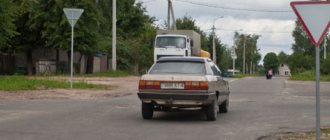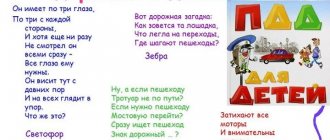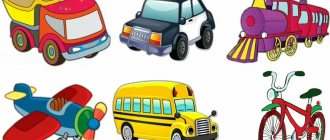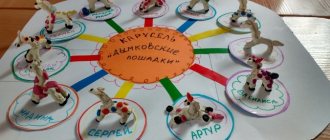Summary of GCD for traffic rules in the middle group “Road Signs”
Lesson on traffic rules in kindergarten “Road signs”.
Middle group Purpose: introducing children to basic traffic rules. Objectives: 1. Introduce children to two types of traffic lights and road signs “Pedestrian Crossing”, “Zebra”, “Bus Stop” 2. Develop a desire to know and follow traffic rules. 3. Expand children’s knowledge about traffic rules and safe behavior on city streets; 4. Develop self-preservation skills; Integration of educational areas: • Social-communicative (formation of the foundations of life safety) • Cognitive development (familiarization with the surrounding social world, the objective world) • Speech development (formation of the grammatical structure of speech, development of coherent speech) • Physical development (dynamic pause)
Progress of GCD
Organizational moment Educator: Children! Did you sleep well today? Did everyone get up without crying? Turn to me, smile! Say hello all together and go on a journey! Let's not sit still! Oh guys, I think I hear someone crying? Did any of you cry? It's not you???? And who is crying? The doll Masha appears (second teacher) Teacher: Hello guest, Who are you? And why are you crying so bitterly? Doll Masha: Hello guys, I'm doll Masha. I lived in a small toy town. But one day an evil and powerful hurricane hit the city and carried me so far that I cannot find my way home. I can’t cross a single road, because there are cars there, they drive and drive... (frowning) Educator: Masha, you can’t cross the road wherever you want, there are traffic rules that pedestrians and cars need to follow. Doll Masha: what other traffic rules? Educator: Now you’ll find out which ones. Guys, I suggest you learn a few important traffic rules and help the doll Masha return home. Do you agree? (children answer yes) Educator: Guys, I have a map that shows how you can get to the toy city. You can get there by bus, but to get there you need to cross two roads. And on the first road there is a very important inspector. Guess who we're talking about. Three multi-colored circles Flashing one after another. They light up and blink - they help people. (showing the “Traffic Light” layout) Educator: The main traffic light on the road. He controls the movement of pedestrians and vehicles so that there are no accidents on the street and everyone moves according to the rules. A traffic light can have three light signals (Traffic Light Demonstration) or two (Layout Demonstration). And these traffic lights are different: one is intended for drivers and pedestrians, the other is only for pedestrians. Doll Masha: oh, I saw one like that, at the intersection near your kindergarten, but I don’t understand why it’s shining there at all.. (pouts) Educator: You’re right Masha, you saw a traffic light for cars and pedestrians, but what kind of light are we talking about? indicates I'll tell you now. • Red signal - The most severe, Stop! There is no further road, the path is closed to everyone!; • Yellow signal – warning, wait for the signal to move; • Green signal – says “Come on, the way is open!” Educator: And for pedestrians, guys, there is a completely different traffic light. It depicts little men: red and green. (Demonstration of the layout) What do you think the red man means? (the children answer that you can’t cross the road, you have to stand), and what about green? (children answer that the path is open and you can cross the road). Guys, how should you cross the road? (children answer with a calm step, holding the adults’ hands) Doll Masha: Thank you, guys, I didn’t know that. Educator: Masha, that’s not all, there are still a lot of traffic rules that need to be followed. Doll Masha: Traffic rules, traffic rules, well, now I know about the traffic light, why are they needed, then these rules? Educator: Traffic rules are special rules that both pedestrians and drivers follow. Without knowing these rules, disaster can happen. A traffic light helps pedestrians cross the road and drive through intersections correctly. But he has helpers. The pedestrian walks boldly along the black and white stripes. Which of you guys knows what the sign warns about? Let the car run quietly - Helps... Doll Masha: Lunokhod?? Educator: No, listen, the guys are telling you this (the children answer PEDESTRIAN CROSSING). Here's the usual transition. People walk along it. Here the special marking “Zebra” is aptly called! White stripes are coming across the street! Where is the pedestrian on the zebra crossing? You find it on the street and cross under it! Such a crossing is indicated by special signs (demonstration of a pedestrian crossing sign) Doll Masha: Thank you guys, now I understand how to cross the road. Educator: Masha, guys, let's play? (Children answer, let's) Physical exercise (to the music from the movie "Leopold the Cat") (Children must show movements)
I'm spinning, twisting, spinning I'm spinning the pedals
(Turning the steering wheel)
Down the mountain, down the mountain , from the mountain I fly like a bird,
(Hands to the sides)
I hurry, I hurry, I hurry, I hurry lightly Towards the rainbow-arc.
(We draw a rainbow with our hands)
Let, Let the road run into the distance
(Running in place)
Let sadness not lie on the heart
(Movements of the heart near the chest)
I can handle everything in the world
(Running in place)
And with this song I roll around the world, I roll, I roll wherever I want.
(Turning the wheel) Doll Masha: Well done, guys. You taught me that you need to follow traffic rules. Now I can safely go home by bus. Goodbye to all of you. (gets ready to leave, the teacher stops her) Teacher: Masha, the buses don’t stop where you want, don’t you know? Doll Masha: What, another rule? Educator: Of course! Buses stop only in specially designated places, they are called bus stops and are marked with a special road sign. (demonstration of the “Bus Stop” sign)
In this place, a pedestrian is patiently waiting for transport.
He is tired of walking, he wants to become a passenger. Here are the rules of behavior at a bus stop. You cannot wait for a bus on the roadway! Stand only on an elevated place. Doll Masha: How stupid I am... I will definitely remember everything and will follow it, and also, guys, I promise you that when I return to my fairy-tale city, I will go to the Traffic Light Inspector and learn all the traffic rules with him. Will you study the rules of the road? Educator: Of course, the guys and I will continue to study traffic rules. What rules did we repeat today? What types of traffic lights are there? (For drivers and pedestrians and only for pedestrians) Where should you cross the roadway? (At a pedestrian crossing marked with markings and a sign) Where should I wait for my bus? (In a specially designated place called a bus stop, marked with a special sign) Well done, guys!
We recommend watching:
Integrated lesson on traffic rules in the middle group of preschool educational institutions Lesson notes - walks on traffic rules in the middle group: Observation of city transport Lesson on traffic rules in the middle group. Rules of conduct in transport Summary of GCD for traffic rules in the middle group of kindergarten
Similar articles:
Summary of a lesson on traffic rules in the middle group on the topic “Rules of conduct in public transport”
Summary of a lesson on traffic rules in the middle group of kindergarten according to the Federal State Educational Standard. Topic: Tram
Summary of a walk according to traffic rules in the middle group. Traffic light
Prohibiting
As the name of the group implies, the signs prohibit the driver from performing any action: passing, turning, overtaking, accelerating, stopping. All prohibition signs are round in shape.
The fines for each sign are different, depending on the situation. For example, entering a closed area under a “brick” is punishable by a fine of 1 thousand rubles for violating the instructions of the sign. And for driving under a “brick” into the oncoming lane, your license will be taken away for 2-4 years.
Cars that have turned on special signals and flashing lights can ignore prohibition signs. The validity of the signs ends at the nearest intersection or at signs that cancel previously introduced restrictions.
Also read: Driving license categories
All Road Traffic Signs of 2022 by type with designation and explanation
It is prohibited to drive at a speed (km/h) exceeding that indicated on the sign.
If you exceed the permitted speed with a difference of up to +10 km/h, a traffic police inspector can stop you if the movement of your car differs from the flow of others, and at the same time give only a warning. Exceeding the speed limit over +20 km/h is punishable by a fine; over +80 km/h - fine or deprivation of rights.
Coverage:
1. From the place where the sign is installed to the nearest intersection beyond it, and in populated areas, if there is no intersection, to the end of the populated area. The effect of the signs is not interrupted at exit points from areas adjacent to the road and at intersections (junctions) with field, forest and other secondary roads, in front of which the corresponding signs are not installed. 2. The coverage area may be limited to tab. 8.2.1 "Area of Operation". 3. To the same sign with a different speed value. 4. Before sign 5.23.1 or 5.23.2 “Beginning of a populated area” with a white background. 5. Until sign 3.25 “End of maximum speed limit zone.” 6. Until sign 3.31 “End of all restrictions zone.”
A difference of up to +20 km/h is allowed due to the fact that the inspector’s “radar” shows instantaneous speed, while the driver’s speedometer shows average speed. The accuracy of the speedometer readings is also affected by the wheel rolling radius (Rk), which is not a constant value; in addition, the speedometer has a rough scale of divisions.
If the sign has a yellow background, then the sign is temporary.
In cases where the meanings of temporary road signs and permanent road signs contradict each other, drivers must be guided by the temporary signs.
Punishment for violating the requirements of the sign: Code of Administrative Offenses of the Russian Federation 12.9 part 1 Exceeding the established speed of a vehicle by at least 10, but not more than 20 kilometers per hour - The norm is excluded Code of Administrative Offenses of the Russian Federation 12.9 part 2 Exceeding the established speed of a vehicle by more than 20, but no more than 40 kilometers per hour - a fine of 500 rubles. Code of Administrative Offenses of the Russian Federation 12.9 part 3 Exceeding the established speed of a vehicle by more than 40, but not more than 60 kilometers per hour - a fine of 1000 to 1500 rubles; for repeated violation - from 2000 to 2500 rubles Code of Administrative Offenses of the Russian Federation 12.9 part 4 Exceeding the established speed of a vehicle by more than 60 kilometers per hour - a fine from 2000 to 2500 rubles. or deprivation of the right to drive a vehicle for a period of 4 to 6 months; in case of repeated violation - deprivation of the right to drive for 1 year Code of Administrative Offenses of the Russian Federation 12.9 part 5 Exceeding the established speed of a vehicle by more than 80 kilometers per hour - 5,000 rubles or deprivation of the right to drive for 6 months; in case of repeated violation - deprivation of the right to drive for 1 year
Information signs

Information signs include blue squares indicating permitted turns, a parking sign, underground pedestrian crossings, signs indicating dead ends, traffic patterns, etc. In addition, these are also signs with the names of cities, villages and streets. In cities they are made in black letters on a white background, on highways - white letters on blue, and on highways - white on green.
Also read: Rules for retaking the traffic police exam
Warning
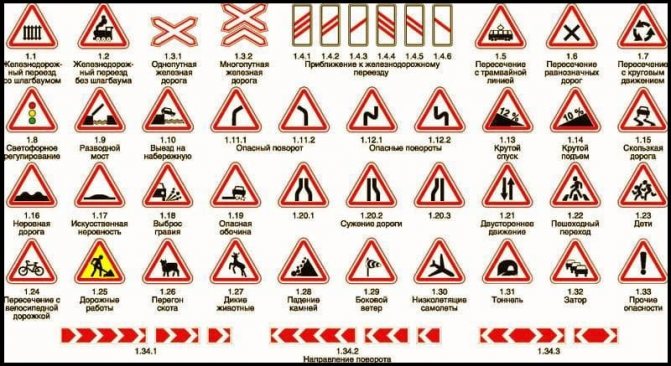
Warning signs are triangular in shape, white with a red edge. The only exceptions to this rule are signs indicating railroad crossings and turning directions.
The requirements of warning signs cannot be violated because they do not prohibit anything. The purpose of these signs is to warn the driver of approaching danger. For example, about the narrowing of the road ahead, the possibility of animals entering the road, slippery roads and dangerous turns.
Such signs are installed 50-300 m from the danger, depending on where it is located - in the city or on the highway.
Also read: Is it possible to get a license without attending a driving school?
Service marks
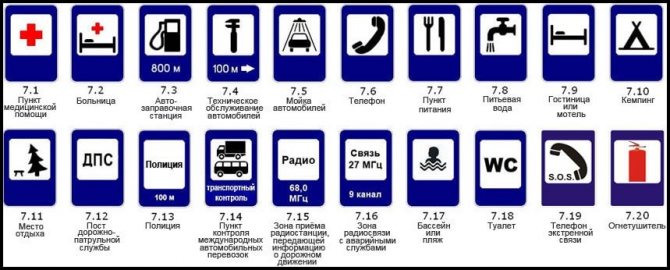
Service markers show where the nearest service station, gas station or rest area is located. Within the city they are installed directly next to the object, and on highways - from 400 m to several tens of kilometers. There are also signs indicating gas stations with sockets for electric cars.
Also read: Traffic controller signals in simple language
